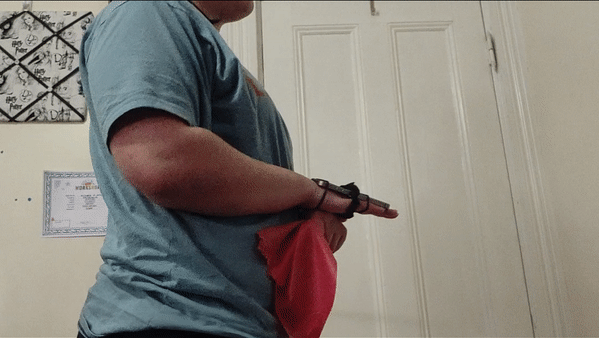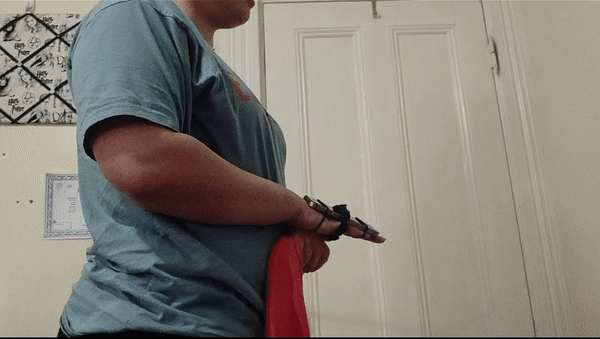MOTION MODEL
Overall Motion Model
_edited_edited.jpg)
The experimental setup of PT Assist is shown in Fig. 1. The user’s smartphone is attached to the top of the hand screen side up, with the camera towards the wrist. This location was deliberately chosen for the phone as it allows us to focus on the motions that define a correct or incorrect pallof press (explained below) and abstract out the motion of the elbow since it does not affect the direction the phone travels when attached to the hand. After consulting with physical therapists, we determined that this exercise is commonly used in a rehabilitation setting and would be valuable to our potential users. To understand how to do a pallof press in more detail, look at this article [4].
Fig 1. Experimental setup coordinate system.
Correct Pallof Press
As modeled in Fig. 2, a correct pallof press occurs in a “linear direction away from the body, resisting the rotational force of the band” [4]. This means there is only one degree of freedom along the y axis of the phone's accelerometer. The user's hands are moving directly perpendicular to their body (x axis) and parallel to the ground (z axis). Therefore, in an ideal world, there would be no movement along the phone's x and z axes and the phone would be moving in a straight line along its y axis. This motion would result in a z acceleration of 9.8 m/s^2 and an x acceleration of 0 m/s^2. We expect an oscillating acceleration in the y axis as the user slows down to change directions after being fully extended and contracted (you can think about this as a mass in simple harmonic motion).

Fig. 2. Correct pallof press.

Fig. 3. Time derivatives of expected oscillation in y axis for correct pallof press.
Fig. 3 shows how the change in position in the y axis is reflected by acceleration in this direction when the pallof press is done correctly. When the arms are at the body (-ymax) and beginning to extend the acceleration is positive. As the arms extend acceleration reaches zero as the motion is momentarily constant. As the arms slow down to change direction, acceleration becomes negative. The cycle moves in reverse as arms are brought back into the body. Other directions are not shown because we expect zero acceleration in the x axis and constant acceleration equal to gravity in the z axis when the pallof press is correct.
Incorrect Pallof Press: Not Perpendicular to Body*

As modeled in Fig. 4, one incorrect way to perform the pallof press is not remaining perpendicular to your body. This error results in two degrees of freedom (along the phone's y and x axes). The user's hands get pulled into the door by the resistance band, leading to a larger acceleration in the phone’s x axis. When analyzed in the frequency domain this behavior is represented by larger frequencies and amplitudes in the x axis than when performing the exercise correctly.
Fig. 4. Incorrect pallof press, not perpendicular to body.
Incorrect Pallof Press: Not Parallel to Floor*
As modeled in Fig. 5, another incorrect way to perform the pallof press is to not remain parallel to the floor. With this error there are two degrees of freedom (along the phone's y and z axes). The user does not stay parallel to the ground, resulting in varying accelerations along the phone's z axis. This results in larger frequencies and amplitudes in the z axis once the data than when doing the exercise correctly when analyzed in the frequency domain.

Fig. 5. Incorrect pallof press, not parallel to floor.
*We consulted Matt Lough, PT, DPT about PT Assist and he informed us that these are the two most common ways patients perform a pallof press incorrectly, and these would be the most beneficial to users.
HOW PT ASSIST WORKS
PT Assist performs four steps to provide feedback to the user.
